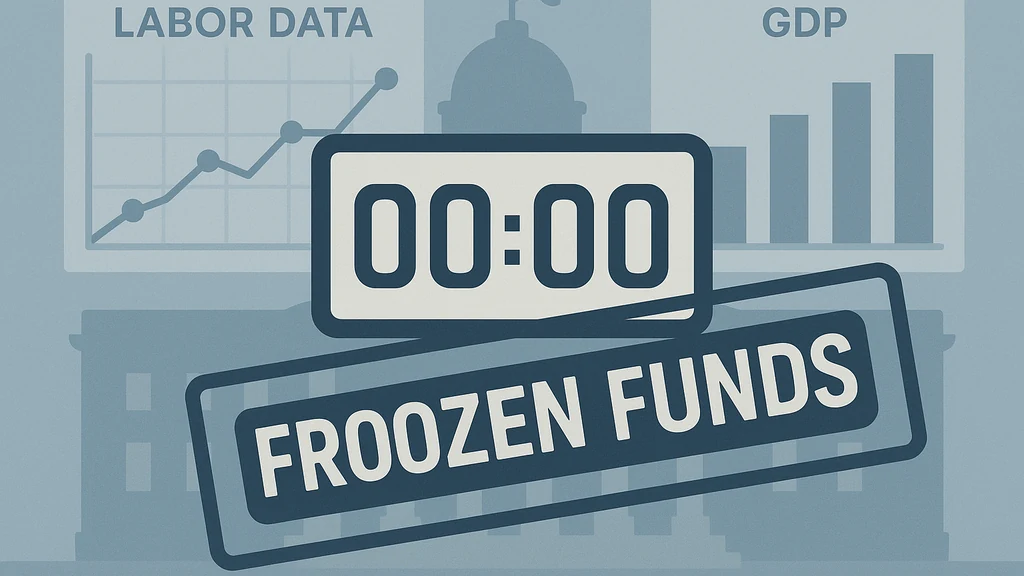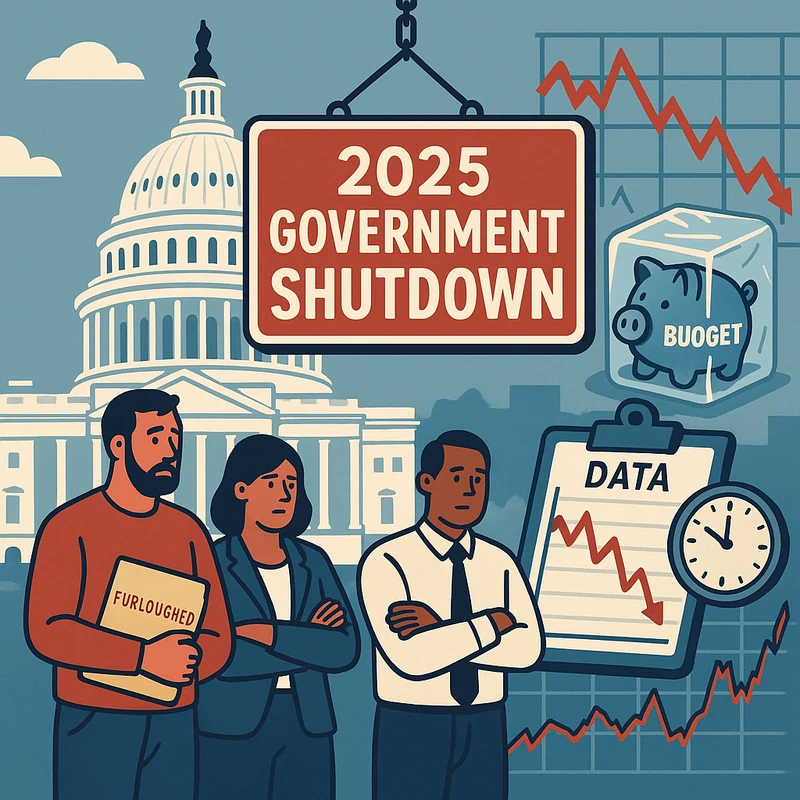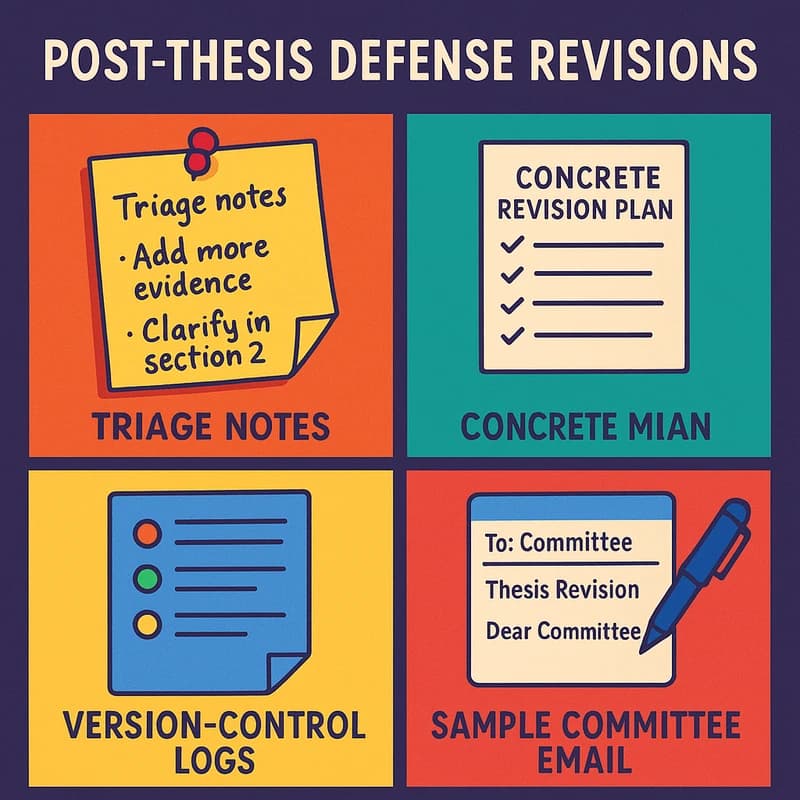US government shutdown 2025 has entered Day 3, freezing funds and delaying data. Discover how it could impact markets, jobs, and planning—read now.
Quick Answer
The US government shutdown 2025 has entered Day 3, freezing billions in federal funds and delaying key data releases. About 800,000 federal workers are furloughed, with roughly as many more performing duties without pay. The White House froze about $26 billion in funds, intensifying the standoff and creating ripple effects for markets and local economies. Economic costs could run from $7 billion to $15 billion per week, depending on duration and knock-on effects. Data releases from the Labor Department and other agencies are lagging, complicating sentiment and decision-making for policymakers and businesses alike.
Key Takeaway: This shutdown blends budget fights with data delays, making immediate economic signals harder to read while the clock ticks on negotiations.

Complete Guide to US government shutdown 2025
A government shutdown happens when Congress fails to pass funding legislation for the new fiscal year, forcing nonessential federal operations to pause. In 2025, the dispute centers on spending levels and health-care subsidies, with essential functions continuing under contingency plans. Here’s a structured explainer built to answer core questions and give you a practical sense of what’s shifting, what’s still operating, and what might come next.
-
The current situation at a glance
- 800,000 federal workers furloughed; hundreds of thousands more on duty without pay
- About $26 billion in federal funds frozen by the White House
- Weekly economic cost estimates in the $7–$15 billion range
- Data releases slowed or delayed, including the Labor Department’s Employment Situation report
- Markets exhibit higher volatility as uncertainty persists
-
Why this matters for tech-minded readers
- Government data that businesses rely on (employment, GDP, price indices) could be delayed, affecting product roadmaps, hiring plans, and investor confidence
- Contingencies in federal procurement and grants can ripple into startup funding cycles, university research, and local innovation programs
- The shutdown highlights how fiscal policy, data transparency, and regulatory timing intersect with youth culture and the tech economy
What is a government shutdown?
When Congress cannot pass funding bills or a continuing resolution, nonessential federal operations pause and many agencies suspend most discretionary activities. Essential services—national security, public safety, emergency response—continue, but with limited staff and disrupted programs. In 2025, this translates into 800,000 furloughed workers and a pause in many data releases that policymakers and businesses count on.
- Real-world impact: delayed grant decisions, paused regulatory reviews, and slower federal contracting
- Economic intuition: think of a software project missing critical funding—progress slows, and downstream partners wait for a green light
Key Takeaway: A shutdown is fundamentally a funding timing problem that refracts through employment, data, and program delivery.
How long can a government shutdown last?
There is no fixed legal maximum; length depends on political will, budget negotiations, and the use of stopgap funding measures. Historically, shutdowns have ranged from a few days to several weeks. The 2025 scenario hinges on whether lawmakers can bridge differences on spending caps and subsidies, and whether a stopgap (continuing resolution) or full funding bill is agreed and signed promptly.
- Practical implication: the longer the stalemate lasts, the deeper the ripple effects on households, small businesses, and state budgets
- Market signpost: prolonged pauses tend to widen financial market volatility and complicate economic forecasting
Key Takeaway: Duration is determined by political dynamics, not by an automatic clock; expect periods of flux until a funding resolution is enacted.
What data is delayed during a government shutdown?
Key economic and labor statistics can be paused or released later than usual. In 2025, the Labor Department’s Employment Situation report (the monthly jobs snapshot) is specifically delayed. The Chicago Fed has produced real-time estimates to fill some gaps, indicating the unemployment rate near recent trends even as official data lag.
- Other data likely affected: GDP components, consumer price indices, and surveys that rely on federal approvals or large data collection efforts
- Implication for investors and planners: delayed data reduces the precision of short-term macro signals, increasing uncertainty for fiscal and monetary decision-making
Key Takeaway: Data delays muddy the economic picture, which complicates decisions for policymakers, businesses, and households.
How does a government shutdown affect the economy?
Direct costs come from furloughs and halted services, plus ripple effects in consumer spending, business contracting, and government support programs. Early estimates place weekly drag in the range of $7–$15 billion, with potential longer-term consequences if the shutdown persists. Confidence and investment decisions can short-circuit as uncertainty grows, while lenders weigh risk and rate expectations.
- Sectors most exposed: housing programs, research grants, federal procurement, and data-dependent industries (tech, finance, and manufacturing)
- Regional impact: states that rely heavily on federal funding for infrastructure, health care subsidies, or disaster response tend to feel the pinch more quickly
Key Takeaway: The economy bears a combined direct hit from funding gaps and indirect effects on confidence, spending, and investment.
When will the government reopen after a shutdown?
reopening hinges on Congress passing and the president signing a funding agreement. Without a clear date, markets and households must brace for ongoing uncertainty. In past episodes, temporary funding patches have bought time but delayed a larger budget resolution; the path forward in 2025 remains contingent on negotiations, political calendars, and votes.
- Watch for: emerging CRs (continuing resolutions), budget blueprints, and any bipartisan deal that unblocks funding
- House vs. Senate dynamics: timing often reflects where economic pressure is strongest and how leadership negotiates concessions
Key Takeaway: Reopening is a political milestone tied to legislative consensus and timely passage of a funding bill.
How many workers are furloughed during a government shutdown?
About 800,000 federal workers are furloughed in the standard nonessential category. The number can vary with the type of shutdown and which agencies are deemed nonessential or essential, but 2025’s initial impact follows the familiar pattern: a large portion of the federal workforce placed on unpaid leave.
- Temporary hiring or redeployment: some federal functions may reallocate staff to critical operations
- Recoupment: back pay is typically processed once funding resumes, though timing varies by agency
Key Takeaway: The furlough figure signals the scale of disruption across government services and the broader economy.
What is a federal funds freeze?
A freeze halts new spending or disbursements against nonessential programs, constraining government operations and delaying grant decisions. In 2025, a funds freeze compounds the stall in policy implementation, delaying economic relief programs, research funding, and federal vendor payments.
- Regional consequences: state and local programs that depend on federal funds may slow or halt, affecting services and employment
- Long-run risk: repeated freezes can erode trust in federal program timing and disrupt planning for universities and private partners
Key Takeaway: A funds freeze is a blunt instrument that slows economic and social programs, amplifying downstream disruption.
How does a government shutdown affect markets?
Financial markets react to uncertainty, funding gaps, and the risk of delayed data. Expect increased volatility, bid-ask spreads in government securities, and shifts in yields as investors price in political risk and potential policy delays. The 2025 scenario adds a real-time data layer, since analysts must work with lagging official statistics while markets digest headlines and policy signals.
- Investor considerations: timing of policy responses, central bank cues, and the durability of the shutdown
- Business planning: firms relying on government contracts, subsidies, or data inputs face timing risk and contingency planning needs
Key Takeaway: Market reactions are a function of risk appraisal and information gaps, not just the shutdown itself.
What sectors are most impacted by a shutdown?
- Federal contractors and research institutions dependent on federal grants
- Local governments relying on federal funds for services and infrastructure
- Data-driven sectors that rely on timely government statistics (tech, finance, analytics)
- Public health and safety programs that rely on federal support for certain activities
Key Takeaway: The shutdown hits contractors, local governments, and data-dependent sectors hardest, creating a web of delayed activity across the economy.
How is unemployment data affected during a shutdown?
The official unemployment metrics can be delayed; however, real-time estimates from regional Federal Reserve banks or independent analysts may attempt to bridge the gap. In 2025, a Chicago Fed real-time estimate suggested unemployment held near 4.3% for September, even as official monthly data lagged.
Key Takeaway: Real-time estimates help, but they’re not a substitute for official monthly data, complicating payroll decisions and policy debates.
Engagement Hook
If you’re building a small business or a student startup relying on federal funding or data, now is the moment to map dependencies on government timelines, identify alternative data sources, and build contingency plans that don’t hinge on a single funding stream.
Related topics for deeper reading (internal linking ideas)
- Fiscal policy and the budget process
- Federal procurement and grants administration
- Economic data collection and statistical methods
- Data transparency and real-time economic indicators
- Labor market dynamics and unemployment reporting
- Regional economic resilience and federal funding
- Budget reconciliation and continuing resolutions
Key Takeaway: A solid understanding of the budget process and external data dependencies helps you navigate a shutdown with less disruption.
Why This Matters
In the last 3 months, the US government shutdown 2025 has moved from a purely political standoff to a visible, data-shaping event that touches households, markets, and regional economies. The combination of a $26 billion funds freeze, 800,000 furloughed workers, and widespread data delays magnifies the stakes for investors, students, researchers, and small businesses.
-
Recent developments:
- The White House’s $26 billion funds freeze is sharpening political stakes and signaling a harder line in negotiations.
- Labor data delays complicate decision-making for employers, lenders, and policymakers who rely on timely unemployment and payroll statistics.
- Economists warn the shutdown could cost the economy billions per week, with estimates in the $7–$15 billion range, depending on duration and ripple effects.
- Real-time unemployment estimates (e.g., Chicago Fed) suggest September’s unemployment rate around 4.3% despite delayed official reports.
-
Trends to watch:
- Data visibility: markets and policymakers are operating with incomplete macro data, increasing the risk of mispricing and misinterpretation.
- Regional impact: states with higher federal reliance on funding programs may experience sharper slowdowns in local services and employment.
- Fiscal strategy: the likelihood of temporary funding patches versus a longer-term funding agreement will shape the near-term trajectory for markets and the economy.
Expert insights you can use:
- Analysts emphasize the importance of liquidity planning for households and small businesses during data delays.
- Economists caution that extended uncertainty can dampen consumer confidence and hiring plans, potentially creating a self-reinforcing downturn in the near term.
Key Takeaway: The shutdown’s relevance goes beyond politics—it affects data reliability, economic momentum, and regional resilience, changing how people plan, invest, and innovate in real time.
People Also Ask
What is a government shutdown?
A government shutdown happens when Congress fails to pass funding legislation, causing nonessential federal operations to pause while essential functions continue. This can lead to furloughs, delayed data, and disrupted services.
Answer: It’s a funding lapse with broad operational and data effects, not a collapse of the entire government.
How long can a government shutdown last?
There is no set limit; duration depends on political negotiations and the use of stopgap funding. Past shutdowns ranged from days to weeks, with longer episodes tied to budget fights.
Answer: It can last days to weeks or longer, depending on how quickly lawmakers reach a funding agreement.
What data is delayed during a government shutdown?
Key macro data such as the Labor Department’s Employment Situation report and other federal statistical releases may be delayed.
Answer: Official employment, GDP, price, and other economic data can be postponed, reducing near-term visibility.
How does a government shutdown affect the economy?
Direct costs from furloughs and halted services ripple through consumer spending, investment, and government contracts, potentially costing billions weekly.
Answer: Expect slower growth, reduced hiring momentum, and higher uncertainty in markets and planning.
When will the government reopen after a shutdown?
Reopening follows congressional passage and presidential signature of a funding bill or continuing resolution. The timing depends on political negotiations and concessions.
Answer: There’s no fixed date; it hinges on legislative action and a negotiated funding package.
How many workers are furloughed during a government shutdown?
About 800,000 federal workers are typically furloughed, with others working without pay depending on agency policies.
Answer: The scale is large and immediate, affecting many federal operations and services.
What is the federal funds freeze?
A funds freeze blocks new spending or disbursements for nonessential programs, delaying projects, grants, and procurement.
Answer: It slows program delivery and disrupts planning across federal and partner organizations.
How does a government shutdown affect markets?
Markets react to policy uncertainty and delayed data, often increasing volatility and distorting short-term price signals.
Answer: Expect higher volatility, with investors re-assessing risk and schedule-sensitive decisions.
How is unemployment data affected during a shutdown?
Official unemployment data can be delayed; some real-time estimates may attempt to fill the gap, but they’re not substitutes for official releases.
Answer: Official data gaps can hinder policy decisions and business planning.
Are essential services guaranteed during a shutdown?
Some services (national security, public safety, air traffic control, federal court operations) continue, but many programs and services pause or slow.
Answer: Essential operations run, but nonessential activities pause, creating service and timing disruptions.
How should individuals plan during a government shutdown?
Plan for potential pay delays, job insecurity in some sectors, and the need to monitor official data releases and policy signals.
Answer: Build a contingency plan, diversify information sources, and prepare for a cautious budgeting period.
Next Steps for you
- Track official updates from the White House, Congress, and federal agencies to anticipate the next policy move.
- Watch for a potential continuing resolution or funding bill to gauge timing for reopening.
- Consider diversifying data sources for investment or planning purposes during periods of data delay.
- Explore related topics like fiscal policy, budget processes, and economic indicators to build a robust understanding of the broader context.
Key Takeaway: The path forward depends on political agreement, but proactive planning—across data, finance, and operations—helps you mitigate the impact of the shutdown on personal and professional fronts.
Related topics to explore for deeper understanding and internal linking (4–6 ideas)
- Fiscal policy and the budget process
- Federal procurement and grants administration
- Economic data collection and statistical methods
- Data transparency and real-time indicators
- Labor market dynamics and unemployment reporting
- Regional economic resilience and federal funding
Overall Key Takeaway: The 2025 US government shutdown blends political brinkmanship with concrete real-world effects—data delays, payroll disruptions, and market jitters—making it essential to understand not just what is happening, but how to plan around the consequences for individuals, teams, and communities.
If you want more practical, real-time checklists for students, developers, or small teams affected by a government shutdown, I can tailor a concise guide with sector-specific steps and timelines.



